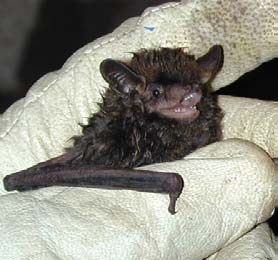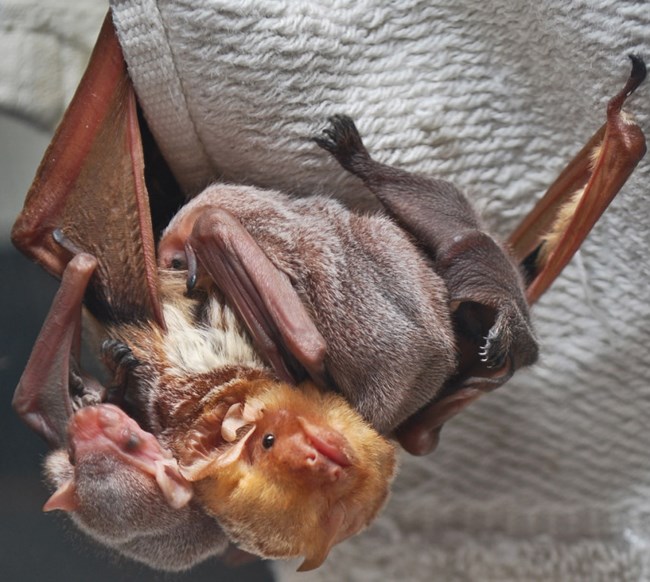Last updated: March 22, 2019
Article
Bat Acoustic Monitoring at Knife River Indian Villages National Historic Site

NPS/Pipe Spring National Monument
Overview
Knife River Indian Villages National Historic Site is a 1,749-acre park just north of Stanton in central North Dakota that protects and interprets the remains of historic Hidatsa villages. The upland woodlands and cottonwood forests along the Knife and Missouri rivers provide foraging and roosting habitat for bats. Some bats can eat thousands of mosquitoes each night, making them important for insect control in the croplands that surround this park.
The Northern Great Plains Inventory & Monitoring Network monitors bats to detect long-term trends and to get early warning of undesirable changes in bat populations and activity at the park. A fungal disease called white-nose syndrome is spreading quickly, threatening bat populations in North America. First documented in a New York cave in 2006, this disease is associated with more than seven million bat deaths. It spreads primarily from bat to bat and humans might be spreading the disease by carrying nearly invisible fungal spores on their shoes and clothing from one cave to another. Bat monitoring helps us understand changes occurring with the spread of this devastating disease.
Acoustic Monitoring
Four acoustic recording stations were established in 2015 at Knife River Indian Villages National Historic Site: one near the visitor center, two along the Knife River, and one in the woodlands area. Acoustic recorders detect the unique ultrasonic calls bats use for echolocation. There were 18,058 bat call recordings from stations across all survey nights from 2015 to 2017. The data were analyzed through specialized software programs that make preliminary identifications of the bat species based on individual call characteristics, such as frequency and shape. Some bat species make calls that are similar to other species, which is why researchers with special expertise review the calls and make the final species determinations.

NPS
Bats in the Park (2015- 2017)
| Common Name | Scientific Name | 2015–2017 |
|---|---|---|
| Big brown bat | Eptesicus fuscus | Present |
| Eastern red bat | Lasiurus borealis | Present |
| Hoary bat | Lasiurus cinereus | Present |
| Silver-haired bat | Lasionycteris noctivagans | Present |
| Western small-footed myotis | Myotis ciliolabrum | Probably Present |
| Little brown bat | Myotis lucifugus | Present |
| Long-legged myotis | Myotis volans | Present |
- Eastern red bat and western long-legged myotis were new detections for the park. Hear what an eastern red bat sounds like!
- Silver-haired bats were most commonly recorded on the park, followed by big brown, hoary, and little brown bats. The threatened northern long-eared bat (Myotis septentrionalis) was not detected though it may occasionally visit the park.
- The highest bat activity was in the upland woodlands where trees, especially the dying trees with loose bark, provide quality roosting habitat. The peak activity time in the woodlands was just before dawn, a good indication that bats are swarming there before roosting for the day.
- Peak bat activity near the visitor center was after sunset, but with no second peak before dawn probably indicating that bats use this area for foraging only.
- The lowest activity was along the river in an area with small trees. The Missouri River riparian forest is being cleared for agriculture so it will be very important to conserve the remaining forests and large trees in the park to protect important bat roosting habitat.

© Josh Henderson (https://creativecommons.org/licenses/by-sa/2.0/legalcode)
White-nose Syndrome
White nose syndrome has not yet been detected at the park, but the fungus (Pseudogymnoascus destructans) that causes it was detected at Badlands National Park in 2017, southwest of Knife River Indian Villages National Historic Site in South Dakota. See a map of white-nose syndrome in national parks and learn more about how you can help prevent the spread of this fungus. Continued monitoring, and park staff and visitor observations, will help us protect the bat communities that live and forage in the park.
For More Information
Dan Licht, Midwest Region Wildlife Biologist
Protocol Contact: Northern Great Plains Network
Summary by Tani Hubbard, updated in 2019
